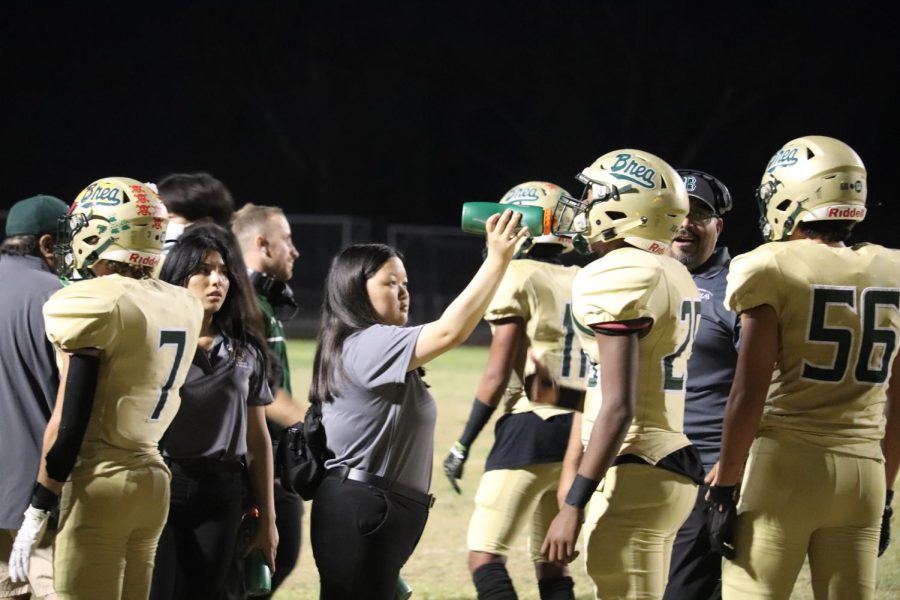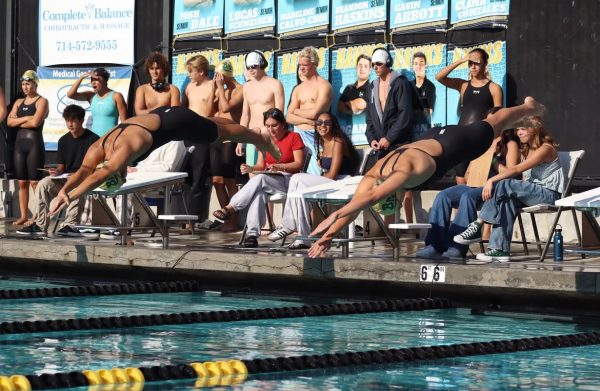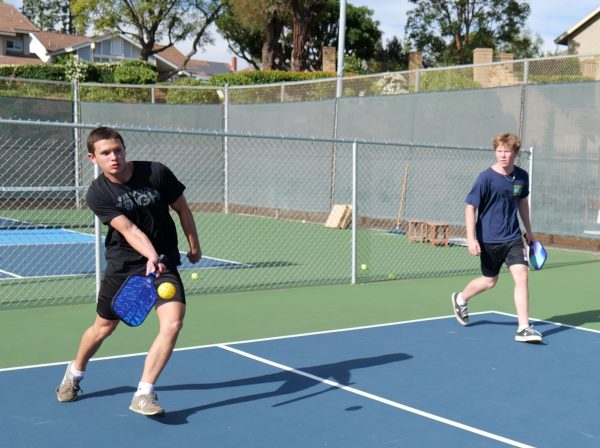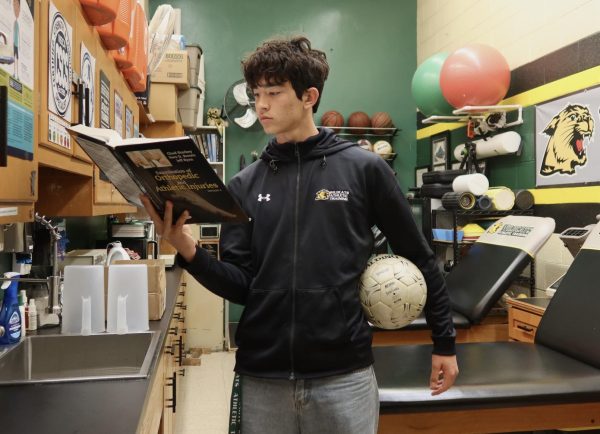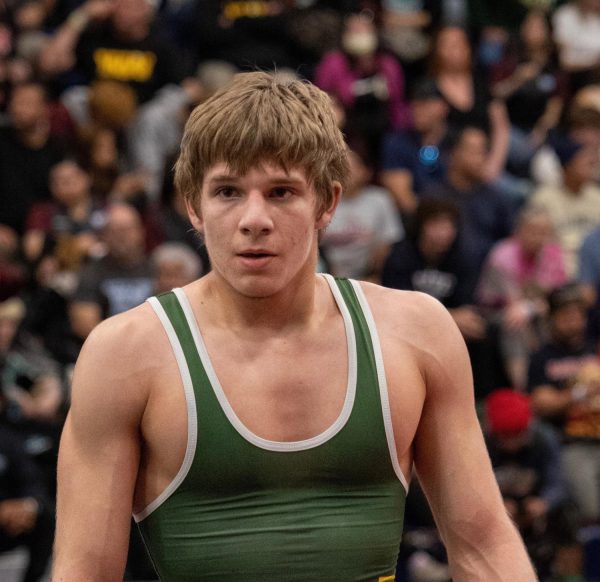Team Behind the Tape
Joanna Park, senior and Athletic Training Student Aide (ATSA), gives water to varsity football players at the Homecoming game against the Comanches. ATSA stand on the sidelines to observe and treat athletic injuries that may arise on the field.
Behind the scenes of every ice bag, tape job, and wound care for athletes, is an Athletic Training Student Aide (ATSA) dedicated to helping the physical and mental well-being of athletes.
The ATSA program consists of 22 interns that shadow, observe, and assist the head Athletic Trainer and patient care pathway teacher, Ken McCall. Interns either follow teams to games or assist in duties inside the Athletic Training Room (ATR), such as administering first aid, performing injury evaluations, and providing treatment.
McCall started the ATSA program in 2006 to give BOHS students the opportunity to explore the profession of athletic training. “Born with 6 interns” in the first year with only one medical class available at BOHS, the Patient Care pathway has grown into two medical classes on campus and more than triple the number of student aides, McCall said.
Athletes like Avery Hager, junior and track athlete, feel that the ATSA Program has improved her well-being as an athlete. The aides “give [me] tips on how to keep my body healthy, [and] I trust the services they offer,” she said.
McCall and the interns oversee all 24 sports at BOHS, both on-and-off seasons. “We would be lost without [the ATSA team],” Mike Knaus, Athletic Director, said. “[McCall] and his assistants do a great job keeping our athletes healthy, supporting [injured] athletes on their return,” he said.
All interns are certified in CPR and first aid so that they have the necessary skills to act in life-threatening medical situations. Most interns also have prior medical knowledge from completing the Medical Careers and Sports Medicine courses at BOHS.
Minjoo Yang, senior, completed the Patient Care pathway classes at BOHS and has been in the internship program for 2 years. “It’s one thing to memorize vocabulary words and do word dissection in class and another to get hands-on experience working in a real medical environment,” she said.
Prior to caring for athletes hands-on, student aides must be proficient in the skill to guarantee professional and effective treatment to athletes. This requires learning the technique through a demonstration from McCall, repeating the action back to him, explaining the task to a peer, then showing competence of the skill through a final demonstration.
With three levels of proficiencies, student aides learn all skills, ranging from making gatorade, cleaning, and wrapping ice bags to CPR, advanced taping techniques, and concussion protocols.
“I think I practiced taping at least 100 times before taping an athlete’s ankle for the first time,” Aubrey Fessler, junior, said. Fessler is now able to tape ankles in under two minutes before games.
Aides go to various home and away games to provide medical care to injured athletes and make sure that only non-injured athletes are on the field. They also help athletes before and after games and practices.
“I witness a lot of injuries on the field, and it’s amazing to watch an athlete recover through rehab until they can go back to play,” Fessler said.
Varsity volleyball player, Rachel Joung, junior, received muscle therapy in the ATR after practices. The staff is “kind and considerate, giving me a thorough exam and providing me with anything I needed,” she said.
Many interns in the program are interested in pursuing a career in health care, hoping to further professional experience by interacting with patients.
Anwei Forgues, senior and ATSA, is interested in pursuing a career as a Physical Therapist in the future. “I am so grateful for this program for allowing me to truly find my passion [and] get hands-on experience,” she said.
Graduates of the ATSA Program continue to expand their medical knowledge past high school. Christine Cheon (22’) is an undergraduate at USC studying chemistry. The internship “strengthened my resolve to become a pre-med student,” she said.
In order to become an intern, student aides are required to complete at least one medical-related course in high school, and are selected based on an application and formal interview process.
Evelyn Torres (‘17), graduate of CSUF with a BA in kinesiology and ATSA, interviews the applicants to see if they would be a good fit for the program. When interviewing interns, “Simply knowing that they have interest in the program or medical field is a good start,” Torres said. With such a broad range of talents, the purpose of the program is to “educate and open one’s eyes [because] everyone has something to bring to the table,” she said.
Your donation supports the student journalists at Brea Olinda High School! The contribution will help us purchase equipment, upgrade technology, and cover our annual website hosting costs.
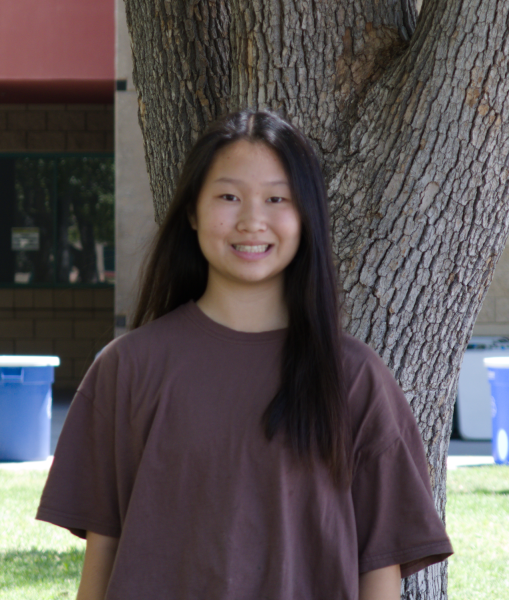
Ellen Kim, senior, has been a member of the newspaper staff since her freshman year and is excited to lead the staff as Editor-in-Chief. Alongside her...



